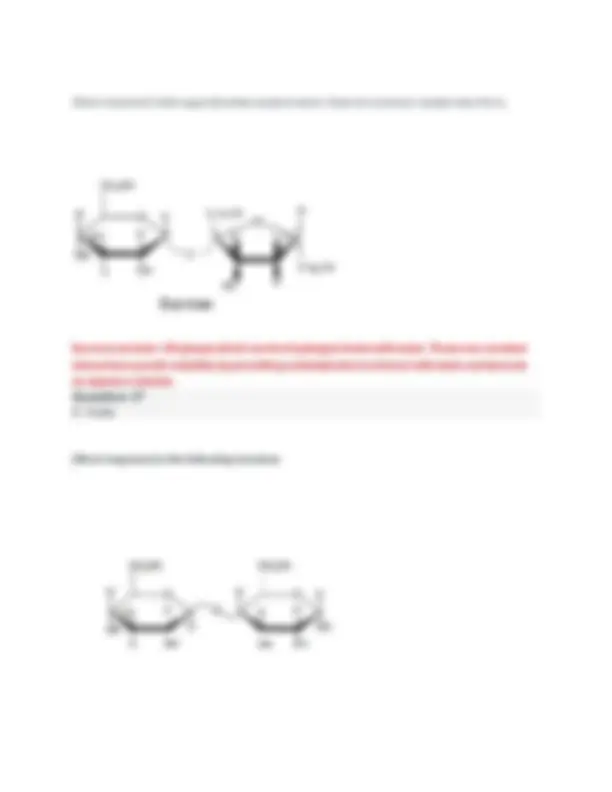











Study with the several resources on Docsity

Earn points by helping other students or get them with a premium plan


Prepare for your exams
Study with the several resources on Docsity

Earn points to download
Earn points by helping other students or get them with a premium plan
Community
Ask the community for help and clear up your study doubts
Discover the best universities in your country according to Docsity users
Free resources
Download our free guides on studying techniques, anxiety management strategies, and thesis advice from Docsity tutors
CHEM 210 Biochemistry Module 4 Exam Portage Learning Questions and Verified Answers, 100% Pass This document provides all verified questions and answers for the Module 4 Exam in CHEM 210 Biochemistry at Portage Learning. It focuses on key biochemical processes such as enzyme regulation, coenzymes, and metabolic control mechanisms. Perfect for targeted revision and ensuring a 100% success rate with thoroughly vetted content.
Typology: Exams
1 / 17

This page cannot be seen from the preview
Don't miss anything!










3 / 3 pts
3 / 3 pts
Which of the following monosaccharides is a ketose? Dihydroxyacetone Galactose Glucose Glyceraldehyde Idose Dihydroxyacetone When two carbohydrates are epimers: One is a pyranose, the other a furanose One is an aldose, the other a ketose They differ in length by one carbon They differ only in the configuration about one carbon atom They react differently with iodine THEY DIFFER ONLY IN THE CONFIGURATION ABOUT ONE CARBON ATOM Which pair is anomeric? A) D-glucose and D-fructose B) D-glucose and L-fructose C) D-glucose and L-glucose D) - D-glucose and - D-glucose E) α-D-glucose and β-L-glucose D) - D-glucose and - D-glucose
3 / 3 pts
3 / 3 pts
3/ 3 pts Which statement about starch and glycogen is false? A) Both have β-D-glucose monomers B) Both starch and glycogen are energy storage polysaccharides C) Both are homopolymers of glucose D) Glycogen is more extensively branched than starch E) Both have O-glycosidic linkages A) Both have β-D-glucose monomers Which monosaccharide is not a six-carbon monosaccharide? Fructose Ribose Mannose Galactose Glucose RIBOSE The two monosaccharides shown below could best be described as:
3 / 3 pts Anomers Aldoses Ketoses Epimers Pentoses EPIMERS Which arrow correctly identifies the atom that will become the anomeric carbon?
3 / 3 pts B The following monosaccharides are covalently bonded. What type of bond unites them? A) α1 → 4
0 / 3 pts
3 / 3 pts B) α1 →β C) 1, 4 D) α1 → 6 E) β1 → 6 D) α1 → 6 Which statement about cellulose is true? Cellulose is the primary storage polysaccharide of animal cells Cellulose is a highly branched polysaccharide Cellulose is a homopolysaccharide The glucose residues of cellulose contain the same configuration as the glucose residues of amylose Cellulose is an anomer of chitin CELLULOSE IS A HOMOPOLYSACCHARIDE The polysaccharide cellulose is most chemically similar to: Glycogen Dextrose Glycogen Chitin Starch
3 / 3 pts
Which letter represents the hemiacetal bond?
3 / 3 pts
What is the configuration of the following compound? A) α B) β C) D
3 / 3 pts
3 / 3 pts
Cl N Some carbohydrates form a(n) structure, which resembles a structure in proteins. A) α form B) β-turn C) βeta-sheet D) D-configuration E) α-helix E) α-helix The equilibrium between structures is called mutarotation. A) Anomer and epimer B) α and β
3 / 3 pts
3 / 3 pts C) L and D D) Helix and beta sheet E) None of the above B) α and β Consider the functions of carbohydrates. Which of the following is not a function of these molecules? Structure Energy storage Enzyme structure Both A and B Both A and C ENZYME STRUCTURE The word saccharide means. Sugar Carbohydrate Energy molecule Sucrose Starch SUGAR
5 / 5 pts
5 / 5 pts 5/ 5 pts A) In the above structure, how many monosaccharide units are furanoses and how many are pyranoses? B) What is the linkage between the monosaccharides? C) Is this a reducing sugar? A) 2 pyranoses; 0 furanoses B) β 1 → 4 C) yes, it has free anomeric carbon
(Short response) A hiker is lost in the wilderness and without food. He runs across several beetles with hard chitin exoskeletons. Would he get nutrition in the form of glucose from eating these beetles? Explain. The human enzyme cannot break down the bond between the glucose residues in chitin. The bond is a β 1 → 4, but human enzymes only act upon α 1 → 4. So, no he should not eat the beetles as food.
(Short response) What is the difference between amylose and amylopectin? Amylose is a single chain of glucose molecules connected by alpha 1 → → 4 linkages. This molecule contains a single main chain. Amylopectin also contains a main chain of glucose residues connected by alpha 1 → → 4 linkages, but it has branches every 24 to 30 glucose residues. The branches are alpha 1 → → 6 linkages, which have branch chains that are also connected by alpha 1 → → 4 linkages.
(Short response) A) Which carbon in the following molecule determines if the molecule is D or L? Indicate the letter corresponding the correct carbon (“A”, “B”, etc.) and explain. B) Is this molecule D or L? Carbon E. It is the penultimate carbon and tells the viewer if the sugar is D or L. This monosaccharide is D.
5 / 5 pts